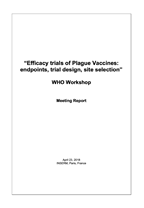Plague
Plague is an infectious disease caused by Yersinia pestis, a zoonotic bacterium, usually found in small mammals and their fleas. As an animal disease, plague is found in all continents, except Oceania. There is a risk of human plague wherever the presence of plague natural foci (the bacteria, an animal reservoir and a vector), and the human population co-exist. There are large plague reservoirs in African, Asian, and South American continents; but since the 1990s, most human cases have occurred in Africa.
https://www.who.int/news-room/fact-sheets/detail/plague
https://www.who.int/publications/i/item/9789240015579
The WHO mapping tool currently registers over 21 plague vaccine candidates under development, by private and public-sector laboratories. Seven of these candidates have completed a Phase 2 clinical trials.
A WHO Plague Vaccine Target Product Profile (TPP) was developed to provide aspirational guidance to vaccine developers.
In 2018, WHO convened experts in epidemiology, regulatory, preclinical and clinical vaccine evaluation trials, regulatory affairs, statistics, and mathematical modelling, in a workshop to discuss plague vaccine efficacy trials. Based on the available scientific evidence as well as on lessons learned from the public health response to plague outbreaks, the workshop defined generic principles on how to best design, conduct and analyze vaccine trials against plague, “Efficacy trials of Plague Vaccines: endpoints, trial design, World Health Organization".
.
News and Agenda
Latest news
Events
All →Calls
Peer-review publications
Related health topic
Contact us


